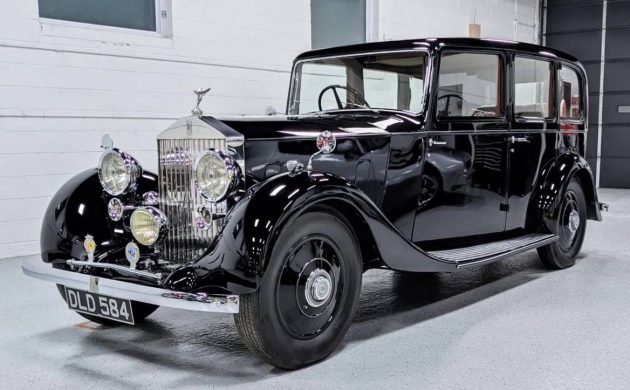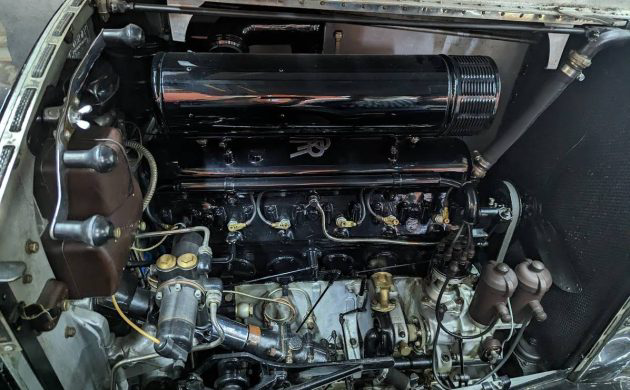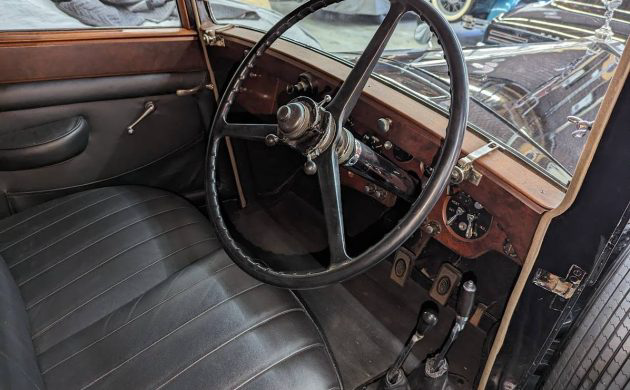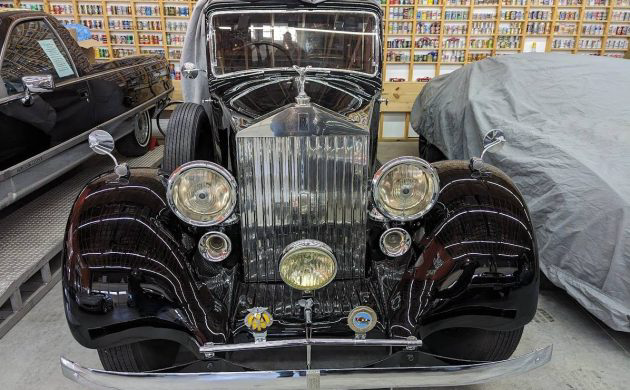
Meeting a specific, rare car over and over again is not uncommon in today’s environment of prolific auctions and online sales sites. Still, I am not sure I’ve met a car so often as I’ve met this 1936 Rolls Royce 25/30 limousine, now here on craigslist with an asking price of $65,000, or $60,000, or offers, or trades! Now in Franklin, Tennessee, the car was residing in Stuart, Florida just a few months ago when it was apparently sold for $21,400. But wait! There’s more! The footloose Rolls was hanging about in Livonia, Michigan back in ’21 when it was listed here, apparently selling for $45,000 (see comments) despite a high bid of $38,000. Confused yet? So was I, so I decided to focus on the model, instead of this particular car, which we need to mention – has a seized motor. We have Anthony M. to thank for sending us down this rabbit hole – thanks for the tip! So now let’s find out what makes this model special…..

The 25/30 followed the 20/25 to bridge a gap before the Wraith was launched in 1938. The new six-cylinder is an improvement over the prior model, with displacement rising from 3699 cc’s to 4257 cc’s, and a dual coil ignition system replacing the magneto. While RR never quoted horsepower ratings, the estimated range of the larger motor was 85 to 115 hp; probably more reliably, the 25/30 is said to top out at 75 mph. Two SU fuel pumps are fitted – a reminder of the virtue of redundancy. A central chassis lubrication system is controlled by a lever under the dash. The mechanical braking system is improved with servo-assist, and continuing the theme of redundancy, the handbrake operates one set of shoes on the rear wheels while the foot brake has its own set of shoes at all four corners. The four-speed ‘box has synchros on the third and fourth; the car can easily start off in second, to avoid the clash of the up-shift. The 25/30 is also “self jacking” which doesn’t mean you don’t need to supply some energy to make them work, but it does mean the jacks are carried on the chassis.

The interior is as expected for a Rolls, with plush features throughout. The chauffeur’s cabin provides leather seating, a wood dash (cracked in this case), a right-hand gear shift, and an e-brake (which you will use in regular driving); behind the seats is a glass window separating the passenger’s cabin from the driver. A set of jump seats folds into the bulkhead cabinet. The rear seats look more comfortable than my living room sofa.

This body is by Park Ward, and it’s had at least one restoration in its past. See that RR beneath the Spirit of Ecstasy radiator mascot, etched in black? Rolls executed that logo in red until 1933 when it was switched to black to avoid clashing with the paint coat. Speaking of the radiator, a thermostat controls its shutters so the car warms faster when it’s cool out, and vice versa. This is an elegant piece but with a seized engine and its scatterplot of past prices, who knows what it’s worth!


Mr. Burns luxury car of death,,,,I could see Winston Churchill riding in the back.
And one of the PM’s most famous quotes might be applicable here to this RR:
“It is a riddle wrapped in a mystery inside an enigma”..
The badge was changed to black to mourn the death of either Mr. Rolls or Mr. Royce. Can’t remember which one it was that passed away
It went to black when Royce died in 1933.
How much will it cost to unseize that motor?
Is the motor seized or just stuck? If it’s stuck that shouldn’t be too expensive to fix, but if it is seized then that’s a whole different kettle of fish! It could cost many thousands of $ to sort that out.
Swap it for an Isuzu diesel!
“Nearly MINT ROLLS ROYCE except for the engine is reportedly seized.”
That’s not a car, it’s a $60,000 piece of furniture. Pass.
I have to laugh, the write up is fantastic concerning the history of this Barn finds veteran. Looking at the price history I think someone’s been drinking too much.
We’ve had both a 20/25 and a 25/30; with first “all hands on deck” knowledge to keep them running too.
Seized motor? Fughettaboutit!!! Use it as an anchor and drop in some American iron with AC, especially if you want to use this as a limo for weddings.
They are fragile, full of wood behind metal, look very cool from the front but if you go full-Resto with this one, your spouse will leave you, your children, grandchildren and great-grandchildren will be destitute and they will all collectively hate your guts.
In fact, since they won’t be able to sell it either when you croak, they’ll use it for your coffin.
Dramatic? Not at all.
Let me show you the bookcase and file cabinets full of receipts………I’m not bitter mind you because I made the decision on my own, eyes wide open on two old R-R’s.
I’m just trying to save the next wide-eyed, would be purchaser who has a dream!
It looks very 1931-32 for a 1936 car.
nipnt, that is typical of RR. Few of their models, even to this day, reflect current styling. Always a decade or so in arrears.
Until the Cullinan that is.
And WAY better than the first Bentayga series.
I had the initial series and we couldn’t trust it for a successful trip around the block without AAA on speed dial.
Switched to our Cullinan and never looked back.
Pictures #19, 23, and 24 appear to be a different car than pictures #5, 11, and 12.
Back around 1970 I was perusing the neighborhood looking for old cars. I was driving my 1950 Chevy 2dr fastback. I came across a Jaguar XK120 coupe light blue with red interior sitting in a guy’s backyard. Also sitting in the garage was a 1936 aluminum bodied Rolls-Royce Limousine. He had brought both cars back from Scotland to North Carolina. He said the Rolls-Royce was owned by the Queen of Scotland at one time. It also had a seized engine. He was asking $1,500. Needless to say my dad told me I did not need either one of these cars. A friend of mine’s father actually ended up with the Rolls-Royce. As far as I know he never did anything with it other than put it in his garage. Could this be the same car? Possibly! Seems to have too many similarities.
This one came from California.
This one came from California. Man had died and left it to a nephew.
“He said the Rolls-Royce was owned by the Queen of Scotland at one time.”
Interesting, but a bit of a problem with dates, as the last Queen of Scotland was Queen Ann in 1707, 229 years prior to this Rolls-Royce, or for that matter, ANY Rolls-Royce! [Per Wikipedia]
For anyone interested in buying this car, I do have a complete engine overhaul gasket set, including the copper & asbestos head gasket. The kit contains all R-R factory original parts [no reproduction parts].I also have a 25/30 engine block with a machine shop certification of it’s condition — very rebuildable specifications, and it has ZERO cracks or crack repairs.
The jacking system is not the later Smith’s hydraulic set-up, this car would have had 3 scissor type mechanical jacks, one on the front cross member and one each on the rear leaf springs. a 3-piece jack handle should be included, the jack handle shaft, extension shaft, and the 2-handle winding piece.
Well I was only a teenager and had no clue then and not from Scotland so did not know their history then and not interested in it now. Just repeating what he said.
He probably meant the engineering of the car dated back to the Queen of Scotland. But it is a lovely looking piece of static art.
According to the company Minute Book the first black RR came off the line in ” the fall of 1934″. The change was authorised in 1933 before the death of Henry Royce because ” the red clashes with the coachwork colour selected for some clients and appears more elegant”.
The self jacking system was also used in the other estate car the Armstrong Siddeley.
That was my understanding, re: the color change, had nothing to do with the death of a Rolls or a Royce. Another car that uses the self-jack is early Bentleys – related of course.
My MG Y had a self-jacking system, hydraulic working on front or rear wheels, or on all four wheels. I think it was a Jackall system.
Many English cars had these or similar systems
Garry, You are correct, ALL the YA, YB and YT cars were equipped with the hand-pump hydraulic Smith’s Jackall, with a 3-way valve that allowed for all 4 wheels to be raised, or just the front or rear wheels. The only other pre-war cars I am aware of that came standard with the Jackall was the Lagonda LG6, LG45, V12 and 3-Litre.
For British-built vehicles there were 2 basic self-jacking systems permanently attached to the vehicle; the DWS brand scissor-type, raised and lowered by a hand crank, and a hydraulic system introduced by the Smith’s organization about 1936. Initially it was a hand-operated pump, but after the war the pump was electrified.
For Rolls-Royce, I am only aware of the scissor type being used on the small HP cars like this 1936 25/30, it was on my 1932 20/25 Hooper saloon, 1935 25/30 James Young limousine, and 1937 25/30 James Young saloon. I have heard the DWS was also used on the Phantom II from 1932-36, but I’ve not confirmed this All of the 1936-39 Rolls-Royce Phantom III and Wraith cars used the hand-pumped Smith’s Jackall.
Some post-war Rolls-Royce cars were equipped with the motorized Smith’s Jackall system as optional equipment, mostly on the longer limousine chassis that carried aluminum coachwork. The reason I heard was to prevent the longer alloy & Wood bodies from being warped from the car being raised only at one wheel.
The motorized type of the Smith’s Jackall system was standard equipment on the Vanden Plas Princess saloons and limousines. I have a 1961 Princess limousine [the ex-Royal family’s limo in the USA], and it lifts that huge vehicle until all 4 wheels are about 4″ off the roadway surface.
The same Smith’s pump/motor was also used on most post-war Rolls-Royce & Bentley drophead coupes to raise and lower the convertible top assembly, but only thru the Cloud III and S-3 cars. It may have been used on other British drophead cars too, However I’ve never seen any examples.
Great response Bill! Thanks for your effort and your information.
Bottom line, if you like it, you should have the money to repair it.